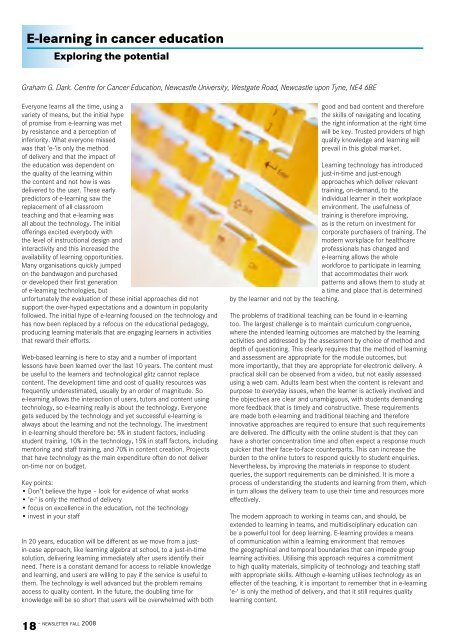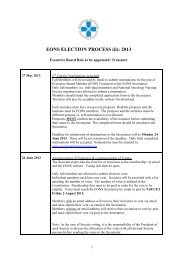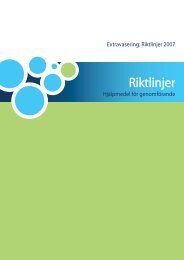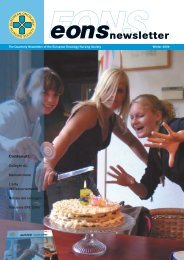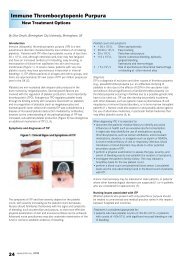English - the European Oncology Nursing Society
English - the European Oncology Nursing Society
English - the European Oncology Nursing Society
- No tags were found...
You also want an ePaper? Increase the reach of your titles
YUMPU automatically turns print PDFs into web optimized ePapers that Google loves.
E-learning in cancer educationExploring <strong>the</strong> potentialGraham G. Dark. Centre for Cancer Education, Newcastle University, Westgate Road, Newcastle upon Tyne, NE4 6BEEveryone learns all <strong>the</strong> time, using agood and bad content and <strong>the</strong>reforevariety of means, but <strong>the</strong> initial hype<strong>the</strong> skills of navigating and locatingof promise from e-learning was met<strong>the</strong> right information at <strong>the</strong> right timeby resistance and a perception ofwill be key. Trusted providers of highinferiority. What everyone missedquality knowledge and learning willwas that ‘e-‘is only <strong>the</strong> methodprevail in this global market.of delivery and that <strong>the</strong> impact of<strong>the</strong> education was dependent onLearning technology has introduced<strong>the</strong> quality of <strong>the</strong> learning withinjust-in-time and just-enough<strong>the</strong> content and not how is wasapproaches which deliver relevantdelivered to <strong>the</strong> user. These earlytraining, on-demand, to <strong>the</strong>predictors of e-learning saw <strong>the</strong>individual learner in <strong>the</strong>ir workplacereplacement of all classroomenvironment. The usefulness ofteaching and that e-learning wastraining is <strong>the</strong>refore improving,all about <strong>the</strong> technology. The initialas is <strong>the</strong> return on investment forofferings excited everybody withcorporate purchasers of training. The<strong>the</strong> level of instructional design andmodern workplace for healthcareinteractivity and this increased <strong>the</strong>professionals has changed andavailability of learning opportunities.e-learning allows <strong>the</strong> wholeMany organisations quickly jumpedworkforce to participate in learningon <strong>the</strong> bandwagon and purchasedthat accommodates <strong>the</strong>ir workor developed <strong>the</strong>ir first generationpatterns and allows <strong>the</strong>m to study atof e-learning technologies, buta time and place that is determinedunfortunately <strong>the</strong> evaluation of <strong>the</strong>se initial approaches did not by <strong>the</strong> learner and not by <strong>the</strong> teaching.support <strong>the</strong> over-hyped expectations and a downturn in popularityfollowed. The initial hype of e-learning focused on <strong>the</strong> technology and The problems of traditional teaching can be found in e-learninghas now been replaced by a refocus on <strong>the</strong> educational pedagogy, too. The largest challenge is to maintain curriculum congruence,producing learning materials that are engaging learners in activities where <strong>the</strong> intended learning outcomes are matched by <strong>the</strong> learningthat reward <strong>the</strong>ir efforts.activities and addressed by <strong>the</strong> assessment by choice of method anddepth of questioning. This clearly requires that <strong>the</strong> method of learningWeb-based learning is here to stay and a number of important and assessment are appropriate for <strong>the</strong> module outcomes, butlessons have been learned over <strong>the</strong> last 10 years. The content must more importantly, that <strong>the</strong>y are appropriate for electronic delivery. Abe useful to <strong>the</strong> learners and technological glitz cannot replace practical skill can be observed from a video, but not easily assessedcontent. The development time and cost of quality resources was using a web cam. Adults learn best when <strong>the</strong> content is relevant andfrequently underestimated, usually by an order of magnitude. So purpose to everyday issues, when <strong>the</strong> learner is actively involved ande-learning allows <strong>the</strong> interaction of users, tutors and content using <strong>the</strong> objectives are clear and unambiguous, with students demandingtechnology, so e-learning really is about <strong>the</strong> technology. Everyone more feedback that is timely and constructive. These requirementsgets seduced by <strong>the</strong> technology and yet successful e-learning is are made both e-learning and traditional teaching and <strong>the</strong>reforealways about <strong>the</strong> learning and not <strong>the</strong> technology. The investment innovative approaches are required to ensure that such requirementsin e-learning should <strong>the</strong>refore be: 5% in student factors, including are delivered. The difficulty with <strong>the</strong> online student is that <strong>the</strong>y canstudent training, 10% in <strong>the</strong> technology, 15% in staff factors, including have a shorter concentration time and often expect a response muchmentoring and staff training, and 70% in content creation. Projects quicker that <strong>the</strong>ir face-to-face counterparts. This can increase <strong>the</strong>that have technology as <strong>the</strong> main expenditure often do not deliver burden to <strong>the</strong> online tutors to respond quickly to student enquiries.on-time nor on budget.Never<strong>the</strong>less, by improving <strong>the</strong> materials in response to studentqueries, <strong>the</strong> support requirements can be diminished. It is more aKey points:process of understanding <strong>the</strong> students and learning from <strong>the</strong>m, which• Don’t believe <strong>the</strong> hype – look for evidence of what worksin turn allows <strong>the</strong> delivery team to use <strong>the</strong>ir time and resources more• ‘e-‘ is only <strong>the</strong> method of deliveryeffectively.• focus on excellence in <strong>the</strong> education, not <strong>the</strong> technology• invest in your staffThe modern approach to working in teams can, and should, beextended to learning in teams, and multidisciplinary education canbe a powerful tool for deep learning. E-learning provides a meansIn 20 years, education will be different as we move from a justin-caseapproach, like learning algebra at school, to a just-in-time <strong>the</strong> geographical and temporal boundaries that can impede groupof communication within a learning environment that removessolution, delivering learning immediately after users identify <strong>the</strong>ir learning activities. Utilising this approach requires a commitmentneed. There is a constant demand for access to reliable knowledge to high quality materials, simplicity of technology and teaching staffand learning, and users are willing to pay if <strong>the</strong> service is useful to with appropriate skills. Although e-learning utilises technology as an<strong>the</strong>m. The technology is well advanced but <strong>the</strong> problem remains effecter of <strong>the</strong> teaching, it is important to remember that in e-learningaccess to quality content. In <strong>the</strong> future, <strong>the</strong> doubling time for‘e-‘ is only <strong>the</strong> method of delivery, and that it still requires qualityknowledge will be so short that users will be overwhelmed with both learning content.18 - newsletter fall 2008


